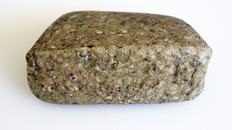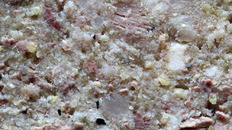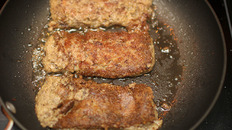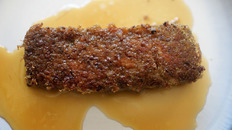Meats and Sausages
Scrapple - Traditional
The original scrapple recipes were created to eliminate waste and use as much of the butchered animal as possible so original scrapple was made of hog offal, such as the head, heart, liver, and other trimmings, which are boiled with any bones attached (often the entire head), to make a broth. Once cooked, bones and fat are removed, the meat is finely chopped and returned to meat broth in which the (dry) cornmeal or buckwheat flour is boiled to make a mush. Seasonings, typically sage, thyme, savory, black pepper, and others are added to broth. Buckwheat was very popular in Germany, Poland and Russia so it comes as not a surprise that the Pennsylvania Germans preferred buckwheat for thickening scrapple. Occasionally, cornmeal or regular flour was used instead of buckwheat, or sometimes combined with buckwheat.
| Materials | Metric | US |
|---|---|---|
| Pork head meat, pork feet, hearts, pork trimmings, liver | 850 g | 1.87 lb |
| Buckwheat or cornmeal flour | 150 g | 0.33 oz |
Ingredients per 1000g (1 kg) of materials
| Salt | 18 g | 3 tsp |
| Pepper | 2.0 g | 1 tsp |
| Allspice, ground | 1.0 g | 1/2 tsp |
| Rubbed sage | 1 tsp | |
| Thyme, dried | 1 tsp | |
| Nutmeg | 1.0 g | 1/2 tsp |
| Cloves, ground | 0.3 g | 1/8 tsp |
Instructions
- Place split pork heads in enough water to cover them and cook below the boiling point until meat separates easily from bones. Remove heads and place on a table to cool. Save meat stock. Remove the meat from the bones, the task is easily performed when the heads are still warm. Cover other meats with water and cook below the boiling point of water until done. Save meat stock.
- Chop all meats finely.
- Bring meat broth to a boil, add spices and start gradually adding the cornmeal, stirring constantly for the first 15 minutes, then reduce the heat and keep on cooking 15 minutes more until all is thorougly combined. The mixture should be thick enough to support a spoon standing on its own. If the mixture gets to thick, stir in more meat stock. Add all chopped meat and cook for an additional 15 minutes stirring occasionally.
- Line up shallow baking pans with waxed paper so that the ends extend over the long sides. Pour the mixture into the pans, allow to cool, cover with foil and place in refrigerator to set and become solid. Slice into 1/4 - 1/2” (6 -12 mm) slices and fry.
Notes
Scrapple
Take eight pounds of pork that will not do for sausage, boil it in four gallons of water, then tender, chop fine, strain the liquor and pour it back in the pot, put in the meat, season it with sage, summer savory, salt and pepper to taste, stir in a quart of corn meal, after simmering a few minutes, thicken it with buckwheat flour very thick, it requires very little cooking after it is thickened, but must be stirred constantly. Note: for even a better flavor soup greens can be added to water when boiling meat. Strain the stock before adding cornmeal. Although cooked scrapple has a form of a meat loaf, nevertheless, the manufacturing process resembles making a head cheese. That is why the recipe is included in this chapter.





















